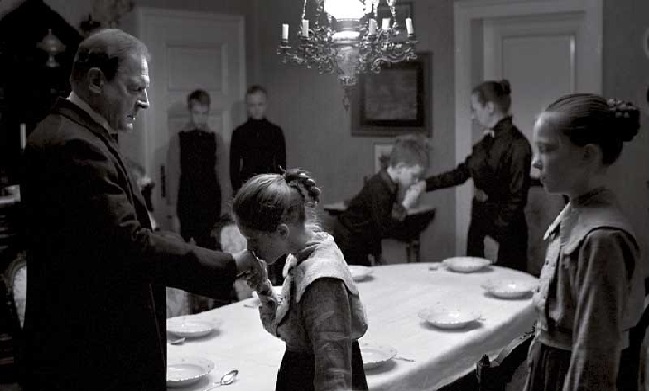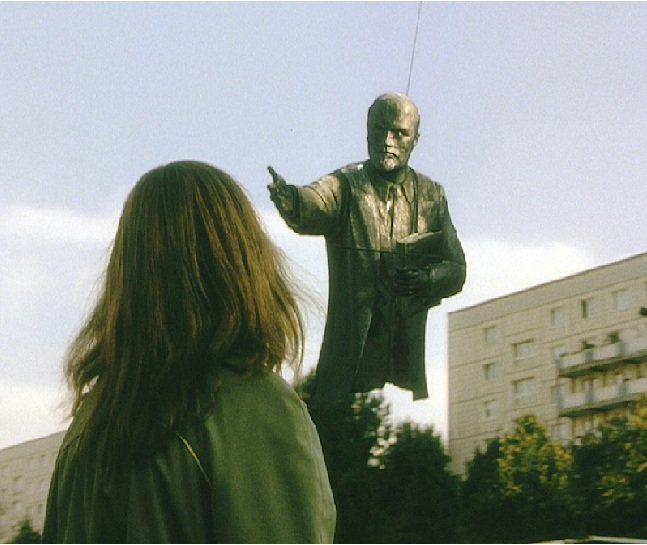Optimism is not something that comes to your mind when you first watch Michael Haneke’s The White Ribbon. It is one of those complex pieces of cinema that can not be fitted into any distinct genre. Set in an idyllic German village just before the World War I, this film is carried forward by a narrator who later turns out to be one of the protagonists of the tale, the village teacher. Apart from him, the village contains some typical characters like the baron, the pastor, the doctor, the farmers and their families. As the narrator unfolds the story, we get to see that the seemingly sleepy and isolated village is suddenly witnessing some mysterious, disturbing and violent happenings. Just at the beginning, the doctor’s horse trips over a wire strung between a couple of trees and the doctor gets severely injured. Did someone plot that? A few days later the wife of a farmer meets with an accident in the mill owned by the Baron and succumbs to her injuries. Was the Baron responsible for it? Then the Baron’s child goes missing and is recovered later in a beaten and bruised state. Was someone taking revenge on him?
As these events set up the basic premise of the film, it takes a break from the grim proceedings and provides us some more insights into the lives of the principal characters. The younger self of the narrator, the teacher is in his early thirties and is trying to woo a young girl who works as a nanny to the Baron’s newborn babies. On the other hand, the Pastor comes off as a strict disciplinarian who ruthlessly imposes his puritanical views on his children. Literally, the “white ribbon”, is basically a ribbon that is tied around the hair of his daughter to signify “purity” in her. He preaches virtues of love but metes out severe punishments to his children for minor offences. On the other hand, the doctor recuperates and returns to the village and soon it is revealed that he also has many dark chapters in his life including his illicit relationship with the midwife. The midwife also has a mentally challenged son who also falls prey to the unknown assailants just as the Baron’s barn is set ablaze by someone.
All these incidents create an impression that something sinister is lurking around the corner and lures the audience into believing that a rustic whodunit is about to unfurl. The teacher gets intrigued by all these disturbing incidents and tries to investigate on his own. At this point, the plotline offers us a bunch of suspects who could be the culprits as well as red herrings. As the film nears its finale, more and more contrasting clues come up. As a matter of principle, what exactly happens at the end of a film should not be disclosed in a review. But actually it is not the kind of film that can be ruined by a few spoilers. Nevertheless, it should be suffice to say that the film ends without offering any definite answers or solutions.
Coming to the technicalities, this film is shot completely in black and white which suites the period as well as the mood of the film. Cinematography is excellent to say the least and it succeeds in creating a sense of claustrophobia even through the open pastures. Another noticeable aspect in this film is the limited use of background music. Only dialogues and atmospheric noises create a very realistic feel without any distractions. The film boasts of a very impressive cast including the children, probably more so because most of these actors are famous or even remotely familiar to me except Burghart Klaußner, as the pastor, who played an important part in Good Bye Lenin.
As far as overall impact of the film is concerned, it works at multiple levels. Haneke uses an unsure and unreliable narrator and drops multiple clues here and there. But in the end, it is not a film that ties up the loose ends. The bizarre incidents are merely the props used to show us the bigger picture. This little village is a microcosm of the society that was going to breed the most dreaded fascists the history has ever known. Superficially, it seems like any other village isolated from the rest of the world with only passing reference to the impending war a few times. But through their constrained yet hypocritical moral values, the characters portray the germination of worse things to come. This subtle yet effective symbolism is the greatest strength of this film. It not only becomes a critique of the early twentieth century German society but also a grim reminder to the possible repercussions of Talibanistic mindset that is brewing up in many corners of this world. One can very well relate to the straight-jacketed and abused children of the film to the ones whose schools are being bombed nowadays. Yes, one can very well argue that it can not be the sole reason for creating such monstrosities as the Nazis but that is where the greatest success of this film lies. It does not give us any answers. It just raises questions and makes us uncomfortable.
It is a film thriving in symbolism that makes it topical and relevant despite its period settings and this is why I find it a reason to be optimistic. When the entire world is in chaos, it is hard to be optimistic. But as I find profound works of art as this, I understand that there are human beings capable of seeing beyond narrow and short sighted biases and look up towards a better world by accepting one’s faults. The White Ribbon not merely criticizes but goes the core of the problem. It is a study so deep and subtle that it may go unnoticed if one views it superficially. It is a film that has to be seen with right set of expectations but it surely rewards the ones who do so.




